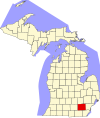
Oberlin College is a private liberal arts college and conservatory of music in Oberlin, Ohio, United States. Founded in 1833, it is the oldest coeducational liberal arts college in the United States and the second-oldest continuously operating coeducational institute of higher learning in the world. The Oberlin Conservatory of Music is the oldest continuously operating conservatory in the United States. In 1835, Oberlin became one of the first colleges in the United States to admit African Americans, and in 1837, the first to admit women. It has been known since its founding for progressive student activism.

Eastern Michigan University, is a public research university in Ypsilanti, Michigan. Founded in 1849 as the Michigan State Normal School, it was the fourth normal school established in the United States and the first American normal school founded outside New England. In 1899, the Michigan State Normal School became the first normal school in the nation to offer a four-year curriculum and gained the name Michigan State Normal College. In 1959, the college became a university and gained its current name of Eastern Michigan University.
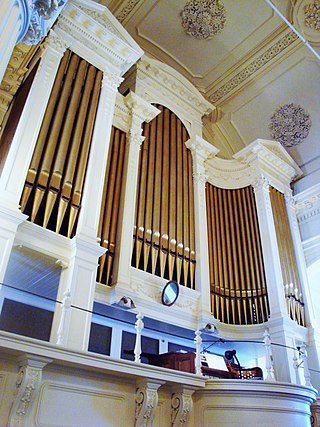
Æolian-Skinner Organ Company, Inc. of Boston, Massachusetts was an American builder of a large number of pipe organs from its inception as the Skinner Organ Company in 1901 until its closure in 1972. Key figures were Ernest M. Skinner (1866–1960), Arthur Hudson Marks (1875–1939), Joseph Silver Whiteford (1921-1978), and G. Donald Harrison (1889–1956). The company was formed from the merger of the Skinner Organ Company and the pipe organ division of the Æolian Company in 1932.
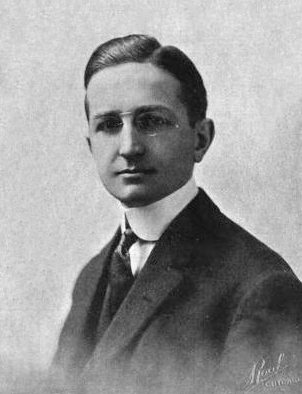
Ernest Martin Skinner was an American pipe organ builder. His electro-pneumatic switching systems advanced the technology of organ building in the first part of the 20th century.

Hill Auditorium is the largest performance venue on the University of Michigan campus, in Ann Arbor, Michigan. The auditorium was named in honor of Arthur Hill (1847-1909), who served as a regent of the university from 1901 to 1909. He bequeathed $200,000 to the university for the construction of a venue for lectures, musical performances, and other large productions. Opened in 1913, the auditorium was designed by Albert Kahn and Associates. It was renovated by the same firm beginning in 2002 and was re-opened in 2004.

The University of Michigan School of Music, Theatre & Dance is an undergraduate and graduate institution for the performing arts in the United States. It is part of the University of Michigan at Ann Arbor. The school was founded in 1880 after Henry Simmons Frieze, founder and president of the Choral Union and the University Musical Society, urged leaders to include music among the school's offerings. The college was known then as the Ann Arbor School of Music. It was later incorporated into the University of Michigan with Calvin Brainerd Cady joining the faculty as the first instructor in music, after already being hired by Frieze to conduct the Choral Union.

Depot Town is a commercial area, with some residences above storefronts, in Ypsilanti, Michigan's historic district. Depot Town proper consists of East Cross Street from the Huron River to North River Street, and a small area on the 300-block of North River Street. However, several blocks in the surrounding area are also commonly referred to as part of Depot Town. These areas include Riverside Park, Frog Island Park, and River Street extending north and south for several blocks. First established in the late 1830s, most of the buildings standing today were constructed between 1850 and 1880. Over the years, Depot Town has included hotels, an Underground Railroad station, an American Civil War barracks, and a building that has housed a bar and restaurant continuously for more than 150 years, switching to soft drinks during Prohibition. Today the area is dominated by restaurants and stores. Depot Town also hosts several large summer festivals each year, as well as weekly bike nights and cruise nights.

The Ann Arbor and Ypsilanti Street Railway, known informally as the Ypsi-Ann, was an interurban railroad operating in southeastern Michigan; it was the first such operation in the state.

Susan Work Martin is an American academic administrator who was most recently the interim president of San José State University. Previously, Martin served as president of Eastern Michigan University in Ypsilanti, Michigan from 2008 to 2015. She was the first female president in the university’s 160-year history. She held a simultaneous appointment as Professor of Accounting in the College of Business during her tenure at Eastern.
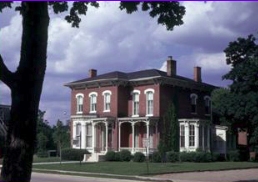
The Ypsilanti Historical Society, founded in 1961, operates the Ypsilanti Historical Museum and Rudisill-Fletcher-White Archives in Ypsilanti, Michigan, United States. The YHS Museum & Archives are located at 220 North Huron Street in the Historic 1860 Dow House. The Historic 1860 Dow House is a Victorian Italianate mansion built in 1860 for Asa and Minerva Dow. Asa Dow moved to Ypsilanti to become the first president of the Ypsilanti Savings Bank. Just four years later in 1864, Minerva passed away under unknown circumstances and Asa sold the home and moved back to Chicago. Minerva Dow was the second person interred at Ypsilanti's newly constructed Highland Cemetery. The house came into possession of the Ypsilanti Historical Society in 1970 after previously being owned by the City of Ypsilanti since 1966. The City purchased the property and other stately homes on the east side of North Huron Street with the design to turn the location into a Ypsilanti version of neighboring Ann Arbor's successful Arborland. Local community members boycotted the effort and the event served as the impetus for the creation of the Ypsilanti Historic District. Prior to 1966 the house was in disrepair, as the home had been turned into at least six apartments since 1922. In 2007 the Fletcher-White Archives moved from the property's two story carriage house into the newly renovated basement of the main house. The Rudisill-Fletcher-White Archives contains a meeting space, a reading room, filing cabinets for document and photograph storage, and a temperature and humidity-controlled storage room. Much of the collections of the YHS Archives are the work product of former Ypsilanti City Historians Louis S. White and Foster Fletcher. The position of Ypsilanti City Historian was discontinued with the retirement of Foster Fletcher and the City of Ypsilanti Archives were transferred from their location at the Downtown Ypsilanti Public Library on Michigan Avenue to the Ypsilanti Historical Society, which has continually grown the collection since.

McKenny Hall, previously called McKenny Union and Charles McKenny Union, was the first student union on the campus of the Michigan State Normal College in Ypsilanti, Michigan. At various times the building has included bookstores, a bowling alley, a bank, a food court, a ballroom, and other social spaces for students. Today the building is known as McKenny Hall and is home to human resources, academic advising, and career services. After the new Eastern Michigan University Student Center opened in 2006, McKenny closed for renovations and structural preservation work. The building is located across from the famous Ypsilanti Water Tower on Cross Street and is a contributing property to the Eastern Michigan University Historic District.

Ypsilanti, commonly shortened to Ypsi, is a city in Washtenaw County in the U.S. state of Michigan. As of the 2020 census, the city's population was 20,648. The city is bounded to the north by Superior Township and on the west, south, and east by Ypsilanti Township. It is home of Eastern Michigan University.
Eastern Michigan University was founded in 1849 by the state of Michigan, and opened in 1853 as Michigan State Normal School. Michigan State Normal School was the first in Michigan and the first normal school created outside the original 13 colonies.

The Eastern Michigan University Student Center is Eastern Michigan University's student union. Since its opening in 2006 the EMU Student Center replaced McKenny Union as the student hub of campus life. The building is simply referred to as "The Student Center" by students faculty and staff. In 2017 the Student Center was named the number one student union in the country by the College Rank. The building is located in University Park near the Rec/IM and Library. It is also the location of the EMU Bookstore, a 24/7 computer lab, two art galleries, various offices and Admissions. The Student Center also includes the Kiva Room.
Ralph Stephens Gerganoff, born Rashko Stoyanov Gerganov, also frequently referred to as R.S. Gerganoff was an American architect.

Starkweather Hall, also known as Starkweather Religious Center, is a religious and educational building located at 901 West Forest Avenue in Ypsilanti, Michigan, on the campus of Eastern Michigan University. It was designated a Michigan State Historic Site in 1972 and listed on the National Register of Historic Places in 1977. It is also part of the Eastern Michigan University Historic District and is the oldest building on EMU's campus.

Eastern Michigan University Historic District is a historic district on the very south end of the Eastern Michigan University campus. Eastern Michigan University is a comprehensive, co-educational public university located in Ypsilanti, Michigan in Washtenaw County. The university was founded in 1849 as Michigan State Normal School. Several buildings since its founding have achieved historical significance and eventually establishing it on the National Register of Historic Places in 1984. The district was established in 1984.
The 1891 Michigan State Normal Normalites football team represented Michigan State Normal School during the 1891 college football season. In the first season of intercollegiate football at Michigan Normal, the Normalites played only two games, losing to Ann Arbor High School (4–34) and the University of Michigan literary team (0–30). James M. Swift was the team's coach.
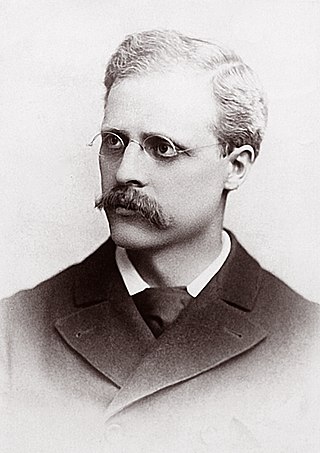
Calvin Brainerd Cady was an American musician, music teacher, leading educational philosopher and writer of the progressive era of education in his subject area.


























